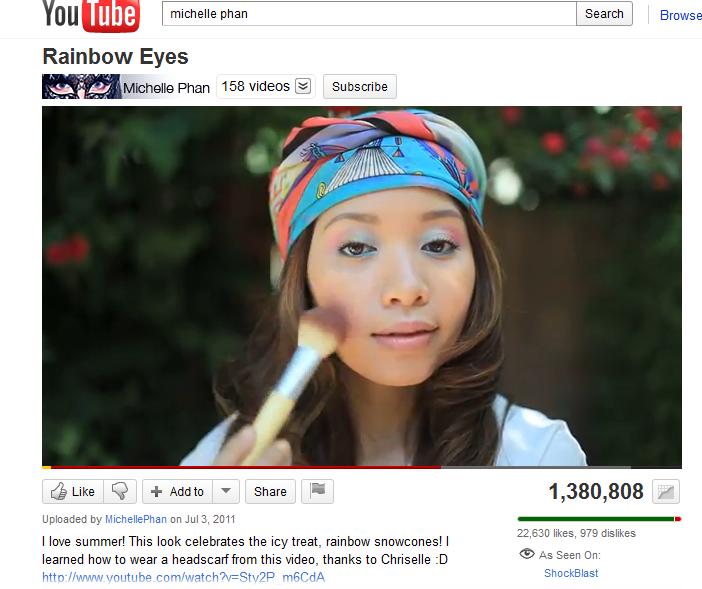The YouTube Beauty Gurus may not be on your radar screen, but they’re popular, controversial, and a great example of what works in online marketing. Think of lolcats, but with products attached.
The screenshot here is of Michelle Phan, the most popular of the beauty gurus and the YouTube woman with the largest number of subscribers — she hit the million mark last November. She has professionally produced videos with good camera work, nice background music, tightly scripted voiceover instructions, and a bit of a story. In this particular video, she is in the park buying snow cones for children when the inspiration strikes her: rainbow eyeshadow! 1,383,808 views later, she has 7,649 comments, most of them saying things like, “You’re so pretty, I wish I looked like you!”
There are lesser beauty gurus who take a less professional approach. Andrea’s Choice, who gets hundreds of thousands of views on her videos, hangs out in her messy girlie room with a dog strolling around, says “anyways” and “like” and “I mean” and shares the contents of her beach bag and her “beauty pantry,” her tips on relationships, and other random ramblings. This is a popular style of video; a little time spent researching beauty gurus will show you an amazing amount of dirty laundry and youthful silliness. Views range from a few hundred to a few hundred thousand.
The genre has its own rules. The Phan tutorial style and the chattier style pretty much cover the spectrum of beauty gurus, but there are popular post types: the Haul, where the guru shows you the stuff she bought or was given; the Tutorial shows you how to put on eyeliner or whatever; the Review compares the advantages and disadvantages of specific products.
There are a lot of beauty gurus who come across as ditzy or even downright stupid, and not all of them are pretty. The quality of the posts varies a lot, but the content doesn’t. If you watch 18 videos on “How I Scrunch My Hair,” you will see essentially the same content 18 times.
The average successful beauty guru is an affiliate marketer for YouTube and other companies and earns a few hundred dollars a month plus free goodies sent for review — just like the average successful affiliate marketer in other genres. A few of the gurus earn a good living with their channels, and a few of them have parlayed their YouTube fame into jobs as professional make up artists, models, or other related work. Again, this is the same kind of pattern you can see for affiliate marketers in general. The beauty gurus make me think of lolcats — they have that level of fad success right now — but their online product works the same way blogging normally works.
So, thinking about your own blog, which probably brings you increased search rankings, traffic, sales at your IRL business, and visibility in your industry, what are the lessons you can learn from the beauty gurus?
- Quantity The popular beauty gurus have hundreds of videos up, and they add new ones regularly. Phan started at YouTube exactly five years ago today and, while she’s not the most prolific of the gurus, she has a good quantity of posts and adds new ones regularly. Post regularly and keep it going.
- Value If you want to look like the beauty gurus, you can. The popular ones provide lots of information for free. None of the popular beauty gurus focuses primarily on promoting products or herself, though they certainly promote themselves and their products. The focus is on the information being provided. Apply this to your own blog by making sure it never reads like an ad.
- Personal connection “It’s like having your sister talk to you,” one fan says. Whether they do straight tutorials or tell you all about their trips to the mall, all the popular gurus speak directly to their audiences and foster a sense of direct engagement. You might prefer, for your business, to maintain more distance and speak as from the company to the customers rather than person-to-person, but you can still speak directly to the experience and concerns of your audience.
While the beauty gurus are enough of a cultural phenomenon to be written about in Vogue and Vanity Fair, they also have their controversies and conflicts. There are whole websites devoted to spiteful gossip about the beauty gurus, and a subgenre of anti-guru rants on YouTube itself. “The minute somebody gets polished and their systems are better, people get hateful,” says Rosie. “They’re suddenly like movie critics, trying to find the flaws.”
Most business blogs don’t inspire this kind of anger (jealousy?), but anyone out on the web can meet with negative comments. Be prepared for that, and don’t give up blogging or vlogging when it happens. Just think how many people totally hate lolcats… and how much money I Can Has Cheezburger has made its founders and investors.


Leave a Reply